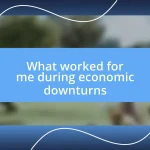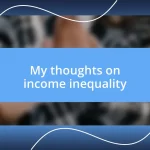Key takeaways:
- Dadaism encourages spontaneity and raw creativity, allowing artists to explore deeper meanings through chaos and absurdity.
- Combining different art forms, such as visual art and music, enhances creativity and fosters unique connections with others.
- Embracing failure as part of the creative process transforms setbacks into opportunities for growth and innovation.

Understanding Dadaism Principles
Dadaism is often seen as a rebellion against tradition, and its principles reflect a profound sense of disillusionment. I remember the first time I encountered a Dada art piece—it was chaotic and vibrant, yet it spoke to the confusion and absurdity I felt in the world around me. Isn’t it fascinating how something so seemingly random can encapsulate deep emotions and thoughts?
At the heart of Dadaism is the idea of chance and spontaneity. This principle resonates with me because it encourages raw creativity without the constraints of conventional artistic norms. I often wonder: what if we let go of our expectations? When I create in this spirit, embracing randomness, I discover layers of meaning that I wouldn’t have found otherwise.
Dadaism also places a significant emphasis on the absurd, suggesting that life itself is irrational and often incomprehensible. Reflecting on my own experiences, I see how Dada invites us to confront uncomfortable truths. Have you ever felt that unsettling mix of laughter and confusion when faced with life’s unpredictability? That emotion is precisely what Dadaism aims to capture, pushing us to explore the depths of our existence through art.

Exploring Personal Artistic Styles
When I think about my artistic style, I can’t help but reflect on the influence Dadaism has had on how I express myself. Each piece I create feels like a dialogue between chaos and clarity, where I layer unexpected elements that, at first glance, seem disconnected. I remember once combining old photos with random newspaper clippings, which led me to unearth memories I hadn’t thought about in years—those fragments spoke to a past I thought I had buried.
- I embrace spontaneity, letting my emotions guide the creative process.
- Experimentation is key; I often mix different mediums, never shying away from the unconventional.
- Each creation is a personal narrative, weaving together fragments of my life and thoughts.
This exploration serves not just as an artistic endeavor but as a reflection of my journey, capturing the essence of my experiences in an authentic way.

Techniques for Dadaist Expression
When expressing myself through Dadaism, I find that collage-making resonates deeply with my creative instinct. There’s something thrilling about taking disparate pieces—like scraps of fabric or old postcards—and transforming them into a cohesive visual statement. I vividly recall a time when I collected items from my surroundings, such as ticket stubs from concerts and pieces of colorful packaging. Combining these elements led me to a surprising narrative about my own life’s chaotic yet beautiful tapestry.
Another powerful technique I adore is the incorporation of text in unexpected ways. Inspired by Dada poetry, I often cut words and phrases from books or magazines, reassembling them into phrases that provoke thought or stir emotions. One particular instance that stands out to me was when I cobbled together a poem using headlines from the daily news to reflect both the absurdity and gravity of our times. The respond I experienced—engaging friends with my “found poetry”—felt like tapping into a shared consciousness, an exhilarating moment of connection.
Performance art also allows me to dive into Dadaist expression in a visceral way. Whether it’s through impromptu spoken word pieces or spontaneous dance, there’s a liberating quality in allowing movement and voice to become part of the artwork. I recall a performance where I danced in my living room, letting my body interpret the strange sounds produced by everyday objects like pots and pans. That experience was a wild celebration of absurdity— both freeing and frightening—showing how art can emerge from the simplest moments of life.
| Technique | Description |
|---|---|
| Collage | Combining various materials to create visual narratives that reflect personal experiences. |
| Text Manipulation | Rearranging words from existing texts to create new, thought-provoking phrases. |
| Performance Art | Embodying art through spontaneous movement and voice, celebrating the absurdity of life. |

Incorporating Humor and Absurdity
Incorporating humor and absurdity into my Dadaist expressions feels like a wild ride. I remember one evening, sitting at my kitchen table, armed with an old typewriter and a collection of quirky objects. As I typed away, I began to create a story where a talking potato became the mayor of a fictional town. It made me chuckle, and in that silliness, I realized how humor could be a powerful tool to challenge norms.
Absurdity often serves as a lens through which I can explore heavier themes, making them more approachable. I once painted a canvas depicting a flock of flying bananas, whimsically expressing my frustration with societal expectations. There’s something liberating about using laughter as a way to disarm my audience; it creates space for deeper conversations. Why should art always be serious? If I can provoke even a light-hearted grin, I’ve managed to connect with others on a different level.
I also find that the unexpected juxtaposition of ideas can reveal profound truths. One day, I created a short video where I narrated a mundane grocery shopping trip, overlaying it with dramatic music and exaggerated sound effects. The contrast between monotony and intensity made the ordinary feel absurdly entertaining. Reflecting on that moment, I realized how embracing absurdity not only amplifies my creative voice but invites others to see the humor in everyday life, encouraging a sense of shared delight in the chaos around us.

Combining Different Art Forms
When I think about combining different art forms, my mind races with possibilities. Recently, I experimented with mixing visual art and music in a way that felt organic and raw. I played my favorite jazz records while painting, allowing the rhythms to guide each brushstroke. It was fascinating to witness how the colors came alive, changing with the tempo of the music, creating a symphony of sight and sound.
Another time, I decided to blend digital art with traditional sketching. I sketched a series of abstract figures and then scanned them into my computer. Using digital tools, I layered vibrant backgrounds, adding an interactive element to each piece. I felt a rush of creativity as I played with textures that wouldn’t be possible on paper alone! Have you ever had a moment where technology seemed to elevate your artistry in unexpected ways?
Sometimes, the fusion of various art forms leads to surprising moments of connection with others. I remember organizing a small gathering where participants could share their own interpretations of Dadaism through different media. One person created a short film while another crafted a series of paintings inspired by the film. Watching how each individual drew from their unique skills to contribute to a unified theme was nothing short of magical. It reinforced my belief that the boundaries between art forms are porous, allowing for a rich tapestry of self-expression that can resonate deeply with others.

Creating Dada-Inspired Projects
Creating Dada-inspired projects is like stepping into a playground where the rules of art are turned upside down. I once found myself crafting a sculpture made entirely of recycled materials, channeling the philosophy of anti-art. As I pieced together an old bicycle wheel, a broken mirror, and discarded plastic toys, I felt an exhilarating connection to the surreal. It was a bit chaotic, but that’s where the thrill of Dada lies—finding beauty in unexpected places.
Exploration is key in this creative journey. I vividly recall an afternoon spent making a collage using magazine clippings of people’s expressions altered by crazy emotions. It fascinated me how juxtaposing their laughed-out faces with serious headlines transformed the concept of communication. Have you ever thought about how simple images, when put together, can tell a story that’s wildly divergent from their original context? That revelation sparked a deeper understanding of how art can distort reality while still making poignant statements about our world.
One of my favorite Dada projects was hosting a spontaneous poetry slam where participants could only speak in gibberish to express their feelings. The energy in the room was palpable as laughter and confusion mingled. In that absurdity, people connected on an emotional level, breaking down barriers of language and expectation. Isn’t it interesting how sometimes the most profound connections happen in a space where logic takes a back seat? That experience reinforced my belief that Dadaism isn’t just about creating; it’s about creating spaces for dialogue and shared experience, no matter how bizarre.

Reflecting on Personal Growth
Reflecting on personal growth through Dadaism has been transformative for me. I remember a moment when I stood in front of my canvas, feeling the weight of self-doubt creeping in. Instead of letting it paralyze me, I splattered paint with reckless abandon, embracing the chaos. That impulsive act not only liberated me from perfectionism but also ignited a newfound confidence in my artistic voice.
As I delved deeper into Dada, I discovered that reflection doesn’t always come from quiet contemplation. I recall a particularly lively gathering where we exchanged thoughts on our creative journeys while crafting unusual paper mâché masks. It was enlightening to hear how others conveyed feelings of isolation and triumph through their unique artistic interpretations. Doesn’t it amaze you how sharing experiences can illuminate the hidden layers of our growth? In many ways, those conversations fueled my understanding of how art speaks to our shared human experience.
Moreover, I’ve realized that my exploration of Dadaism has reshaped my perception of failure. One time, I attempted a mixed media piece that fell completely flat, with materials colliding in unflattering ways. Initially, I was ready to give up, but I chose to embrace that flop as part of my journey instead. I dismantled the piece and reused the components, creating something entirely different and more exciting. This ability to redefine failure reshaped my mindset. How often do we let setbacks define us instead of letting them be stepping stones toward something remarkable? Art, especially Dadaism, teaches us that every misstep can lead to unexpected avenues of creativity.














